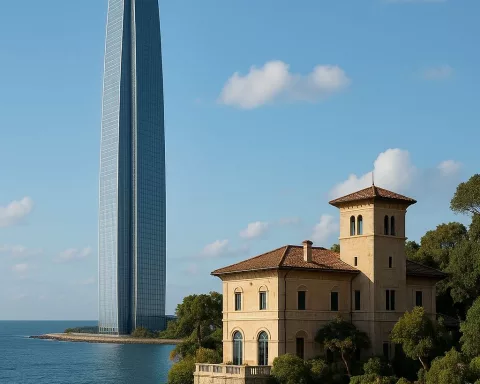The Gleave Album is a collection of photographs from the 1800s to the 1960s that offers a glimpse into the past of Cape Town. The images capture the city’s evolution and constancy, paying tribute to its inhabitants, their lived experiences, and the terrains they dwelled in. From the formative years of Camps Bay to the changing times and glimpses of historical events, the album narrates a tale abundant with intricate details of a city taking shape, making it a precious portal into the city’s history.
The Gleave Album: A Timeless Chronicle
The Gleave Album offers a glimpse into Cape Town’s past, featuring a collection of photographs from the 1800s to the 1960s. Every image pays tribute to the city’s inhabitants, their lived experiences, and the terrains they dwelled in. The album captures the evolution and constancy of Cape Town’s landscapes and cultural fabric, making it a precious portal into the city’s history.
The Gleave Album: A Timeless Chronicle
Cape Town is an enchanting city located at the southernmost edge of the African Continent, celebrated for its mesmerizing allure. This city carries a history as deep and intricate as the landscapes that envelope it. A precious portal into Cape Town’s past is provided through a beautifully preserved family chronicle, known as the Gleave Album. This collection illuminates the progression and constancy of Cape Town, extending from the 1800s up until the 1960s.
The album, widely attributed to A. Jurgen, narrates a tale abundant with intricate details of a city taking shape. Every photograph within this anthology pays tribute to the city’s inhabitants, their lived experiences, and the terrains they dwelled in. Observing these images, it’s impossible to ignore the sense of deja vu. The awe-inspiring sunsets, the towering mountains – these experiences have been communally savored for hundreds of years, encapsulating the mutual admiration of generations.
Early Impressions: Images of a City in Progress
Among the album’s contents is a photograph harking back to Cape Town’s infancy, depicting some of the pioneering vehicles venturing into the untamed lands. This image, immortalizing the debut of wheeled transport in the wild, presents a stark comparison to contemporary times. The evolution from an untamed topography to the manicured cityscape of today is a salute to human effort.
A snapshot from the formative years of Camps Bay divulges a coastal region still pristine, distinct from the vibrant seaside neighborhood it has morphed into today. Yet another striking image, showcasing Hout Bay in its formative phase, encapsulates its simple allure prior to the arrival of modernity.
In a photograph labeled “Sunshine Shadow” Chapman’s Peak Marine Drive, Hout Bay, the initial evidence of mountain cuttings are apparent. This foreshadows the remarkable engineering accomplishment that is Chapman’s Peak Drive today, a widely acclaimed coastal road offering breathtaking oceanic vistas.
Changing Times: Glimpses of Historical Events
Advancing through time, a 1914 photograph reveals troops setting off for the Great War, a stirring reminiscence of the global occurrences that molded the city and its populace. Another picture, displaying the arrival of the Outeniqua in Knysna Harbour, underscores how the docking of ships were landmark events, anticipated with immense excitement.
A picture of Longmarket Street in the Malay Quarter vividly illustrates the dynamism and cultural diversity that has consistently been an integral part of Cape Town’s cultural fabric. The image of Clarensville, a residential area in Sea Point in the 1800s, serves as a reminder of how neighborhoods have evolved over the centuries.
Maritime Memories and Landscapes Transformed
Images of the docks narrate tales of maritime history. Pictures of a German vessel in Cape Town Docks just prior to the declaration of war, and the Alfred Docks/Breakwater before the V&A, offer snippets of the city’s maritime heritage.
The metamorphosis of landscapes is another consistent theme throughout the album. Pictures of Adderley Street awaiting its Captain Percy Scott, and a quick shot of an unpaved road with Lion’s Head in the backdrop, symbolize the city’s evolution through time. Similarly, an image of the onset of motorcars with a sea view in the background speaks volumes about the evolution of transportation over the years.
Final Frames: Beaches and Everyday Life
The album concludes with a lively depiction of Muizenberg, teeming with beachgoers in 1969. This image, in particular, echoes the present, as locals and tourists alike persist in thronging Cape Town’s gorgeous beaches.
The Gleave Album, with its rich assortment of photographs, provides a fascinating journey through Cape Town’s yesteryears. While the images may be reflective of a bygone era, they capture a shared sense of appreciation for beautiful moments and landscapes. This shared sentiment endures today, linking the past to the present, rendering the city’s history both vibrant and timeless.
What is the Gleave Album?
The Gleave Album is a collection of photographs that offers a glimpse into the past of Cape Town, featuring images from the 1800s up until the 1960s.
Who is credited for the Gleave Album?
The album is widely attributed to A. Jurgen, who created a beautifully preserved family chronicle.
What does the Gleave Album capture?
The images in the album capture the evolution and constancy of Cape Town’s landscapes and cultural fabric, paying tribute to its inhabitants, their lived experiences, and the terrains they dwelled in.
What historical events are captured in the Gleave Album?
The Gleave Album offers glimpses of historical events, such as troops setting off for the Great War and the arrival of the Outeniqua in Knysna Harbour.
What is the theme throughout the Gleave Album?
The theme throughout the album is the transformation of landscapes and the progression of Cape Town through time.
What does the Gleave Album symbolize?
The Gleave Album captures a shared sentiment of appreciation for beautiful moments and landscapes, linking the past to the present and rendering the city’s history both vibrant and timeless.








